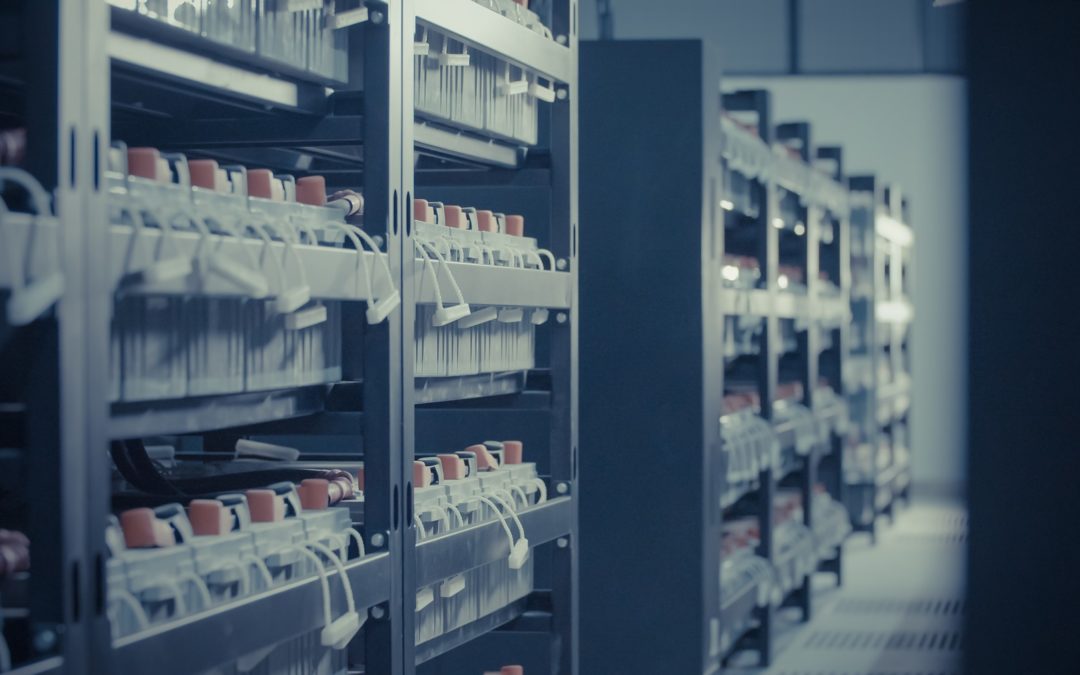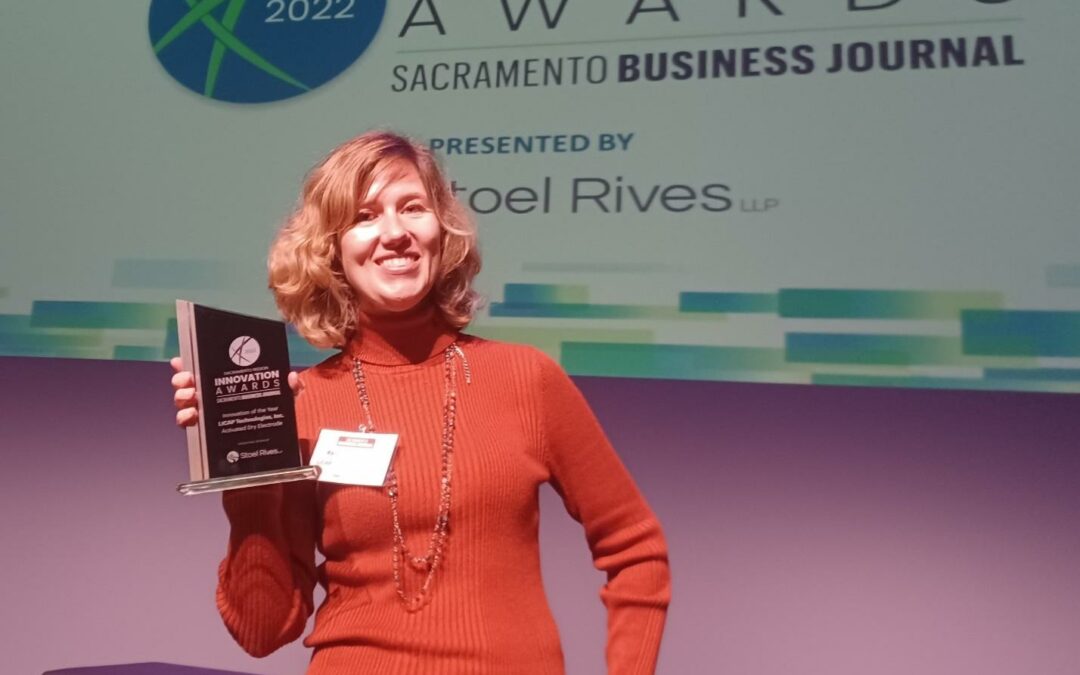


FloraPluse Chosen As Sustainability Innovation Of the Year
Davis-based water use efficiency company FloraPulse received the award as the best innovation in the sustainability category, one of six categories at this year’s ceremony on November 1. FloraPulse has developed a compact technology to measure water stress in orchard crops and vineyards continuously to determine the optimal amount of irrigation required, reducing waste as a result. The alternative technology is slow, clumsy and hard to use, so FloraPulse has the potential to make a serious improvement in how growers apply water to their crops. CEO Dr. Michael Santiago (shown in the picture) brought this technology from his graduate lab at Cornell and founded the company here in 2014. It now has 8 employees and made its first sales in 2018. It has been a long journey, but with many awards along the way. FloraPulse is now gaining traction as farmers deal with the reality of chronic water shortages. Congratulations to the team for its achievements.

ABOUT THE AUTHOR
Gary Simon is the Chair of CleanStart’s Board. A seasoned energy executive and entrepreneur with 45 years of experience in business, government, and non-profits.
CleanStart Sponsors
Weintraub | Tobin, BlueTech Valley, Revrnt, River City Bank
Moss Adams, PowerSoft.biz, Greenberg Traurig, California Mobility Center

Breakthroughs in Long-Duration Energy Storage?
One of the biggest challenges for building an electricity system based entirely on renewable has been the problem of what to do to protect the system in the rare situation where a big transmission line goes down or a big source of generation is suddenly taken off-line or in shifting energy from season to season. Smoothing out the daily mismatches between supply and demand seems now to be on the way to a workable solution with some combination of storage lasting up to 4 hours and more extensive load management. Providing reliable 100-hour energy storage has been more of a problem. The current solution is to keep an inventory of conventional fossil-fuel fired plants at the ready, perhaps with some on-site stored liquid renewable fuel to offset the use of fossil-fuels as much as possible. That solution seems inherently unsatisfying since it can continue the burning of fossil natural gas.
Now two companies have stepped forward with some interesting alternatives—one based on rust and one based on compressing carbon dioxide. The question is whether these are going to be able to meet the claims being made as reasonable solutions.
Form Energy is well-along in developing its iron-air battery system which works by cycling iron from a metallic form to an oxidized form (better known as rust). It has raised $818 million from investors, with $450 million in its Series E in October. That’s a whopping amount considering they are only a 12-person company and haven’t yet done a commercial demo at scale, with one planned in 2023 with Great River Energy in Massachusetts (1 MW discharge capacity and 150 MWh of total stored energy). Bill Gates and Jeff Bezos are big fans and investors. With all that investor enthusiasm, is this the big breakthrough everyone is hoping for?
 Iron-air batteries are not a new idea. NASA was interested in them in the 1960s. They certainly used cheap materials, but cycle life was a problem, with only 20-50 cycles being achieved. Form Energy says it has conquered that problem with a system that should be good for 5000 cycles. Their primary innovation is a “proton pump” which efficiently replenishes protons (hydrogen ions) back into the electrolyte. They also have relatively low power and energy density, which means no one should expect to see them in cars. But for long-duration storage at a fixed site, they could be very attractive. They are aiming for an 85% round-trip efficiency, but apparently are not there yet. If you want more technical detail, delivered in a fun way, go to Matt Ferrell’s site “Undecided” when he covered Form Energy. You can read a critical look at the system in this article.
Iron-air batteries are not a new idea. NASA was interested in them in the 1960s. They certainly used cheap materials, but cycle life was a problem, with only 20-50 cycles being achieved. Form Energy says it has conquered that problem with a system that should be good for 5000 cycles. Their primary innovation is a “proton pump” which efficiently replenishes protons (hydrogen ions) back into the electrolyte. They also have relatively low power and energy density, which means no one should expect to see them in cars. But for long-duration storage at a fixed site, they could be very attractive. They are aiming for an 85% round-trip efficiency, but apparently are not there yet. If you want more technical detail, delivered in a fun way, go to Matt Ferrell’s site “Undecided” when he covered Form Energy. You can read a critical look at the system in this article.
Form Energy claims their solution will be 1/10th the cost of lithium ion storage in terms of $/kWh. Their target is $20/kWh of capacity but of course lithium-ion costs are still coming down as well. They readily admit this will only occur “at scale” and scale is what they are trying to achieve. They have done only relatively small-scale tests at this point. The $818 million is going to optimizing a manufacturing process and doing stress testing to assure the long-life of systems. Lots of finger crossing going on. It feels a bit like a “Hail Mary” with everything riding on the 2023 demo.
 The second is a system developed by Italian company Energy Dome that cycles carbon dioxide from a liquid to a gas and back again, using the pressure of the vaporized carbon dioxide to spin a turbine-generator. There are no technology advances involved. It is an application of existing technology. The idea is like Compressed Air Energy Storage (CAES) systems, but with a twist.
The second is a system developed by Italian company Energy Dome that cycles carbon dioxide from a liquid to a gas and back again, using the pressure of the vaporized carbon dioxide to spin a turbine-generator. There are no technology advances involved. It is an application of existing technology. The idea is like Compressed Air Energy Storage (CAES) systems, but with a twist.
To get the most out of CAES requires liquefying air to get the best energy density. However, that requires cryogenic temperatures which require a lot of energy to reach. Carbon dioxide liquefies at room temperature with the application of about 1000 psi in pressure. That’s not all that much—nowhere near the 5,000-10,000 psi planned for use in gaseous hydrogen storage, for example.
Energy Dome works by storing liquefied carbon dioxide in a series of small high-pressure tanks and then extracting the energy by heating and expanding the gas through a turbine that powers a generator. The liquid expands about 600-fold in volume. The expanded gas goes into a big “bag” that looks like a blimp sitting on the ground. The carbon dioxide is at atmospheric pressure, so the blimp doesn’t have to be very strong. To recharge the system, the carbon dioxide is taken into the turbine-generator working in reverse—the generator becomes a motor and the turbine becomes a compressor.
There are some important details. Compressing the gas heats it up. The gas needs to be cooled back to room temperature to get the carbon dioxide to liquefy. In reverse, heat is needed to get the liquid to evaporate quickly. Energy Dome stores hot and cold fluid to reduce the use of on-site energy to do these two functions. Still the system is more of an energy user than the Form Energy battery, reflected in the 75-80% round-trip efficiency that Energy Dome is targeting.
The primary question with Energy Dome is about cost, not technology. The system requires a lot plumbing, tanks, valves, turbines, etc. While all those are commodity products with known costs, it is the total cost of the system as installed that is important. Energy Dome has partnered with a major European wind farm company, Ørsted. The plan is to build a 20 MW system with 10 hours of storage and have it operational in 2024. Expanding to 100 hours duration is just a matter of adding more pressurized tanks and more “blimps” to the existing compression/expansion equipment. The 2024 demo will be key to seeing whether cost can be contained enough to make this a reasonable solution.
Form Energy is certainly winning the enthusiasm from clean tech investors. Still it has a lot to prove about its technology and about its costs. Energy Dome needs to contain its capital costs. Maybe both will work out. We’ll come back to this next year.

ABOUT THE AUTHOR
Gary Simon is the Chair of CleanStart’s Board. A seasoned energy executive and entrepreneur with 45 years of experience in business, government, and non-profits.
CleanStart Sponsors
Weintraub | Tobin, BlueTech Valley, Revrnt, River City Bank
Moss Adams, PowerSoft.biz, Greenberg Traurig, California Mobility Center

The Story and the Pitch: Straight Talk From Josh David Miller
In coaching clean tech startups, the most frequent question we get is “What should I say in my pitch?” We have our standard guidelines and examples, but nobody explains it better than our friend Josh David Miller. Josh has reviewed over 500 pitches of small early stage companies and has a reputation of asking some pretty blunt questions. Josh and Thomas sat down recently to discuss what makes a good pitch and it was quite insightful. The whole session is recorded [see below]. If you are getting ready to make your first or your hundred and first pitch, you should hear what Josh has to say. Here are some highlights:
1. The best way to get information to stick in someone’s head, to get an audience engaged, is to tell a story. The worst way to begin is by talking about your technology.
2. The story has to describe through examples the problem you are trying to solve and why people should care about your solution.
3. A business is all about solving a problem for someone for a fee. So, talk about not only the problem but who that “someone” is and why. Be incredibly specific.
4. The most important thing to communicate is that you understand your customers and know where they are.
5. Don’t say anything remotely like, “If we could get only a 1% share of the current market, our revenues would be such and such.” It is a flashing neon sign that you have not done your homework and know almost nothing about your customer.
6. The objective of a pitch is to get someone to do something. That “something” is probably to agree to a second meeting. Rarely if ever does someone commit to writing a check based on the first pitch.
7. Research your target audience and what motivates them. If that audience is an investor or a fund, find out what their “sweet spot” is and tailor your pitch to that. Find out what other businesses they have funded. Research any talks they have given where they reveal their investment “thesis”.
8. The first time you make a pitch, it is always a “hot mess.” Don’t let that deter you.
Josh has a lot more to offer and he is willing to meet with you. Check out his bio and his website for his company, Rightbox. And, yes, he is well known as a wearer of bright shoes. Easy to spot in a crowd. The bright red hair helps, too.

ABOUT THE AUTHOR
Gary Simon is the Chair of CleanStart’s Board. A seasoned energy executive and entrepreneur with 45 years of experience in business, government, and non-profits.
CleanStart Sponsors
Weintraub | Tobin, BlueTech Valley, Revrnt,
Moss Adams, PowerSoft.biz, Greenberg Traurig, California Mobility Center

Battery Game-Changer LiCAP Chosen as Regional Innovation of the Year
The overall Innovation of the year award accepted by Katharina Gerber, VP Business Development for LiCAP
The manufacturer of a revolutionary new dry electrode technology, LiCAP Technologies was presented with the overall Innovation of the Year Award at the Tuesday ceremony capping the months-long Innovation Awards program this year. This is the first time a clean tech company has gotten this premier, best-of-the-best award. We had written a blog on clean tech company LiCAP explaining the significance of their game-changing technology for batteries and ultracaps. LiCAP could be the next billion-dollar clean tech company in our region. This latest award gives them the recognition they deserve. Keep an eye on this one.

ABOUT THE AUTHOR
Gary Simon is the Chair of CleanStart’s Board. A seasoned energy executive and entrepreneur with 45 years of experience in business, government, and non-profits.
CleanStart Sponsors
Weintraub | Tobin, BlueTech Valley, Revrnt,
Moss Adams, PowerSoft.biz, Greenberg Traurig, California Mobility Center


